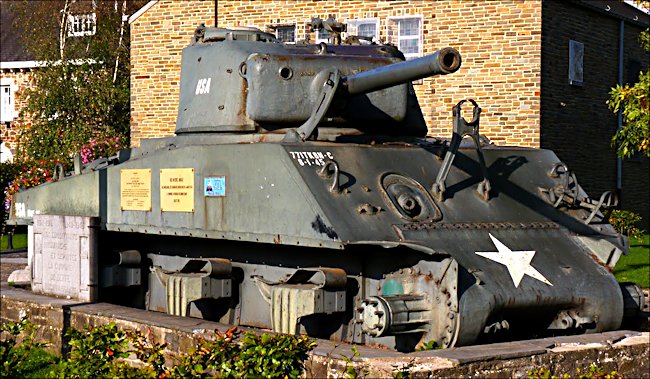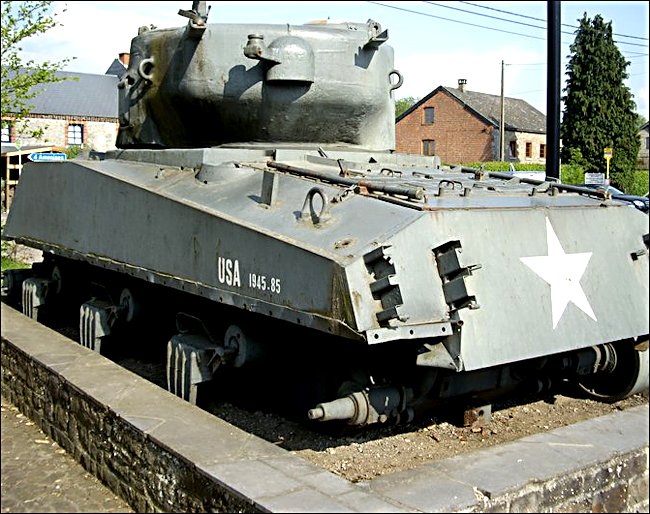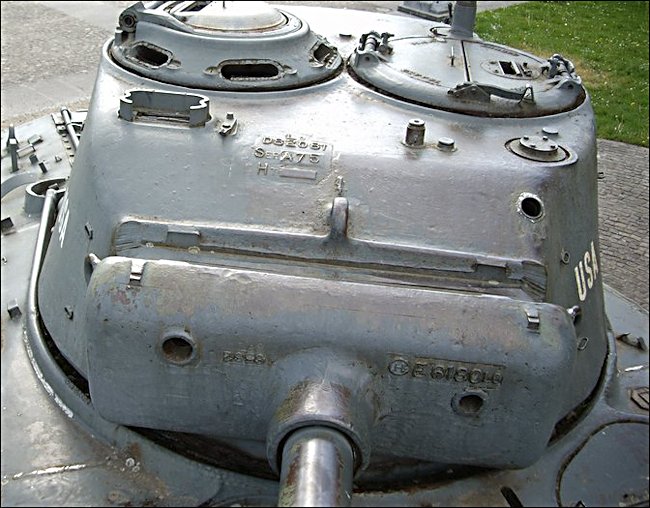Beffe M4A3(76)W Sherman
This Surviving M4A3(76)W Sherman Tank took part in the 1944 WW2 Battle of the Bulge in the Belgium Ardennes. It has been preserved and can be seen near the central roundabout in Beffe where the Rue de l'Eglise meets a road called Sous-le-Tonan.

Surviving M4A3(76)W Sherman Tank in the village of Beffe in Belgium.
This M4A3(76)W was part of C Company 771st tank battalion. During a move from Magoster to Marcourai on the 8th of January 1945, the Sherman slipped on the icy road and slid into the ditch. As the tank was recovered out of the ditch it hit a daisy chain of German mines which disabled the tank and set it on fire. The bogies were destroyed at the time by the mines. Other parts of the tank that are missing were probably taken as spares by the US Army in WWII.
The driver Salvatore DiMartino was killed and the commander Lt. Norbert E. Karl was severely wounded but survived the war. Karl had received a battlefield commission less than a month before. Cpl Frank M. Bottini and T/Sgt Kenneth C. McKnight were also wounded
This Sherman was left abandoned for many years, where it was knocked out beside the road between the village of Magoster and Beffe 5 miles south of Erezee. It was very evocative of the Battle of the Bulge as it was left at an angle in the middle of the fence with its turret pointing forward, but slightly to its right as if taking a at an enemy tank. In December 1984, after 40 years resting in that field undisturbed, it was hauled away and deposited on the concrete base in the centre of Beffe. This tank now bears the markings of 'A' company, 33rd Tank Battalion, 3rd Armoured Division.
The rear decks are not original but were recovered from a range wreck fro the restoration in the 80's. In 1972 the commanders hatch was stolen and kept as a souvenir for 30 years, In 2002 the thief felt sorry about his act and he brought it back. After about 30 years, the hatch was back where it belongs. The co-drivers hatch has been buckled and jammed open since the day it was disabled.

Surviving M4A3(76)W Sherman Tank in the village of Beffe in Belgium
Sherman tank crews have a very bad 1944 Christmas Eve
During the Battle of the Bulge on 24 December 1944, around the village of Manhay, US forces decided to set up a roadblock to stop the German 2nd SS Panzerkorps advance. The German armoured column spotted their position north of the Belle-haie crossroads on the N15 main road about a kilometer up the road towards Mahay. The roadblock was defended by a company of infantry in position around 10 dug in Sherman tanks. It was night time around 10.30pm
The American troops and tank crews spotted the advancing panzers as they came through the night but fatally they took them for American troops. The German column was almost upon the dug in Sherman tanks before the lead German Panther tanks fired flares and shot up the position with its main gun and machine guns.
The blinded and immobilised Sherman tanks were soon disabled. The tank crews bailed out to join the infantry retreating back towards the village of Manhay. The Panther tanks belong to the 4th Kompanie, 2nd SS Panzer Regiment. Only a couple of the Sherman tanks managed to escape back to the village.
The Americans had been planning to withdraw from the village during the night but when news of the German advance arrived the planned withdrawal rapidly degenerated into a rout. As one platoon commander attempted to get two of his Sherman's into a far position that the crucial crossroads in the centre of the village, the situation rapidly deteriorated as one of the Panther's loomed out of the night. It was then every man for himself.

Surviving M4A3(76)W Sherman Tank in the village of Beffe in Belgium
SS Oberscharfuhrer Ernst Barkmann was commander of Panther tank number 401. This is part of his account of the advance of his tanks into American held territory. "We reached the enemy occupied crossroads coming from a south westerly direction. Our Panther's drove on in double column formation and from all our tank's guns we brought coordinated fire on to their recognisable any enemy positions with high explosive shells. After this surprise bombardment, there was hardly any further reaction from the enemy."
"SS Hauptscharfuhrer Frauscher reported by radio that he was pulling away in order to reach the Manhay road which was to be attacked. While turning off the road the leading Panther tank in his section received a direct hit and remained out of action. The second Panther was likewise hit. The section was at a standstill. The commander urged us by radio to continue the attack. I was anxious about my comrade Frauscher and his crew."
"To clarify the situation, I sent a brief message to the company commander to say I had decided to pull away in accordance with what he surely wanted. Without waiting for his reply we moved on making better use of the terrain. My tank reached the road without interference. We crossed over it and immediately turned in the direction of the enemy."
"Using the higher contours of the road, both or observation and cover, we went slowly on, parallel with its celesta reach the leading tank, which had got stuck. We were able to give it protective fire."
"I could not find Frauscher's Panther tank. I learned by radio that it had changed its position and move forward again. We advanced under the protection of the road embankment and after a long time reached the age the woods. Using the moonlight shadows of the tall pine trees. We penetrated into the woods along the roadway."
"About 50 m away on the right there was a tank, which had moved in with its commander standing in the turret. It was apparently waiting for me. In the dark. I thought it was Frauscher in his Panther tank. I moved up to the tank on its left side. As soon as both turrets were on a level with each other. I gave orders to stop and turn off the motor. I started speaking German to the other tank commander."
"In a flash my opposite number disappeared inside the turret and its hatches clanged shut. That tanks driver's hatch lifted the men quickly lowered again. I noticed that the tank was displaying a wine coloured navigation light. That was wrong. The Panther tank's light was green. Then I suddenly realised the tank alongside us was an American Sherman."
"In shock, I quickly shouted on the tank intercom, 'Gunner the tank alongside is an enemy one fire at it'. Within seconds are Panther tank's turret turned to the right and the long 75 mm gun barrel banged against the turret of the Sherman. Over the intercom came the message, 'Gunner to commander, can't fire, turret traverse stuck'. Luckily the driver had been listening without any orders being given, he started up the engine and pulled back a few yards. The gunner loosed off a round into the middle of the rear of the enemy tank at a distance of a few yards. A blue flame sprang out from the circular hole in the rear of the Sherman. As I took cover inside the turret, I heard the detonation as the tank exploded."
"We moved on past burning Sherman tank. From a clearing in the forest on the right two more enemy Sherman tanks came at us. We fired at them immediately. The first one gave out black smoke and came no further. The second one, likewise came to a halt after being hit. The forest suddenly disappeared and in front of this was a clear open grassy area in front of us. I caught my breath. I counted nine enemy Sherman tanks close beside each other. They all had the muzzles of their guns pointing threateningly at our tanks, which until then had been moving unsuspectingly directly towards them."
"Our driver recognise the danger. Standing still or retreating would be suicidal. Only bluff could still save us. So it was a question of escaping in a forwards direction. We moved on ahead without reducing speed. Perhaps we could succeed in passing around them without being recognised and being taken for their own tanks. We had to expose the side of our tank. Their gunners really had us in the bag but not a shot was fired. As soon as we were on their flank I could pick out the backs of all the enemy Sherman tanks drawn up one behind each other. I called halt. We had the best firing position as we only had one enemy tank to deal with. All the rest were blocking each others field of fire."
"I let the turret swing around to 3 o'clock, so as to let the gunner get the targets in his sights. Then I couldn't believe my eyes. The American tank crews jumped out of their vehicles and rushed headlong into the shelter of the Forest that lay behind them. This changed the situation. Those tanks were no longer an immediate threat. We would have been happy to knock out all the enemy tanks but this would have alerted the whole American frontline. I gave the order for tanks forward. We continued the advance towards Manhay. The rear of a column dealt with these Sherman tanks."
WW2 tank books

